Mu-cade: The Physics Centipede Invasion
Mu-cade is a new shoot-em-up by the master of shmups, Kenta Cho of ABA Games. He pitches his game as a “smashup waggly shmup”, which is, by itself, reason enough to check it out. With Mu-cade, Kenta has introduced physics into his formula of hardcore shooting games. The result is a great physics game (even if it will kick your ass in five minutes or less).
A Note on Controls
Before I continue the review, I should point out that Mu-cade begs to be played with a dual-analog controller. It is possible to play with the keyboard, but you don’t really want to. The controls match those of games like Geometry Wars. One thumb stick controls your movement and one controls your direction of fire. If you play on the keyboard you simply lose fidelity and the ability to aim at precise angles. Get a PS2->USB converter, an Xbox 360 USB controller, or something. You’ll be glad you did.
Demented Sumo Gameplay
Mu-cade’s how to play section in the documentation reads in its entirety as follows: Keep your ship from falling down and push enemies out of the way. It’s an elegant premise for a game. You control a snake-like ship on a rectangular playfield. Other centipedes regularly spawn and shoot at you. You don’t have a health bar, and shots don’t do damage. Rather, shots push things around. You die if you fall off, and you kill enemies–and add their segments to your own centipede–by pushing them off.
Player Tactics
The only other action available to the player, in addition to shooting, is the ability to forfeit your tail. In exchange you are given a few seconds of mega-powerful shot. The longer your tail was, the longer this duration. When things get a little too hectic it can be advantageous to drop your tail to hurriedly dispose of your aggressors. Killing enemies grows your tail length again.
Also, you only die if the “head” of your ship falls off the side. When your tail gets long enough it will regularly dangle over the edge. This is harmless and sometimes actually useful–if your tail is hanging over the left side of the stage you can basically absorb any rightward shots without much recoil; your over-the-edge tail will basically act as an anchor. Other times, though, too much of your tail will fall over the edge and start to pull the head of your ship in after it. If you don’t realize this and jettison your tail quickly it will be game over before you know it.
Tall Tails!
Enemy centipedes quickly grow in strength. The game plays out like an old school arcade game. There are no levels; no breaks. Enemies increase in number and strength until you finally succumb to death’s sweet embrace. Things start to get crazy at the three- or four-minute mark. Enemies begin shooting a lot of shots in various patterns. It rapidly becomes a struggle to stay on the game board.
When things heat up, having a long tail practically becomes a requirement. A longer tail means more mass, which means you’re able to absorb more shots without flying all over the place. You can also wrap yourself around blocks and other centipedes in order to make it more difficult for attackers to bounce you around. When you do disconnect your tail out of necessity you really need to build it back up again as fast as possible. I’ve noticed that finding myself tailless is a good recipe for an early demise.
Technical Info
ABA Games is one of the few developers I’m aware of that uses the fledgling D Programming Language. Kenta has developed his own markup language to describe bullet movements, too, which enables him to easily describe various shot patterns and the like. The physics in Mu-cade are powered by ODE.
It’s Free!
Like all of Kenta’s work, Mu-cade is freeware. Download the game here (6.0 MB) or head over to ABA Games’ webpage to check out the rest of his work.
Mu-cade is a slick physics game and an example of how physics can be used to embellish well-trod genres. It’s a neat game and a good challenge. I have yet to pass the 5-minute mark. How far can you get?
Related Posts:
I Hate Clowns: Let Pie Gones Be Pie Gones
I Hate Clowns is a fun little game we developed in the Fall of 2003. It was the run-up to the Independent Games Festival deadline. Along with Beesly’s Buzzwords, we decided to submit whatever projects we had playable at the time. I Hate Clowns was created in the spare time of a very busy three days. The game is a little rough, as a result–the artistic production borderlines on placeholder. The fun is all there, though, so we decided to post it online for the world to enjoy.
Die Clowns, Die
The premise of I Hate Clowns is simple: You throw metal pies at clowns who are being inexplicably launched into the air like skeet shoot targets. You have a limited number of metal pies with which to brutalize these poor entertainers. Take it, clowns!
I Hate Clowns is a physics game in a very pure sense. Except for the scoring, the rest of the game mechanics rest on the physics engine: the ragdoll clowns, the metal pies, the physical dimensions of the playfield, etc. If we ever revisit the project it would be easy to extend the gameplay by designing more complicated playfields with various physics contraptions.
Scoring
Hitting an airborne clown, before he touches the ground, is worth 10 points. Each subsequent pie that smashes that clown before he meets the earth is worth an air combo of 2 points. All hits after that are ground hits and worth 1 point. It is possible for one pie to bounce between multiple targets and rack up multiple points.
Level Progression
Despite the simplistic scoring mechanic, there is some flexibility to changing the player experience. In the early levels most players learn to fire as many pies as possible as fast as possible. This usually results in the wailing akin to the moans of a thousand clowns. Later levels, though, play with the variables. Some levels severely limit pie count and require enough accuracy to pull off air combos at will. One level, “The Saddest Clown”, gives you 50 pies and a high point goal, but with only one clown (who truly becomes the saddest clown of all). There are 47 levels in total.
The Player Experience
Our goal with the game was to avoid complicated game mechanics and required learning curves. Instead, we just wanted the player to have fun and laugh a little. The sounds inch up to insanity, each level name is a terribly horrible pun, and we play a little with time scaling by slowing some levels down and speeding up others. The end result is the game is fun to just pick up and play for a few minutes. No explanation needed.
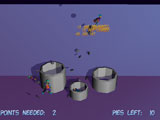
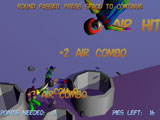
(I Hate Clowns Game Screenshots)
Play Free, Online!
The game is available to play right in your web browser with the Virtools Web Player. If you already have the player installed, the game is ~800k. Otherwise you’re looking at a few MB install beforehand. Check out the landing page for the game right here.
Mile Pie Club
I Hate Clowns was a fun project that took well under 10 hours to crank out. It certainly won’t make us any money; I’d be surprised if anyone would be willing to pay for something this sparse. Still, it’s a hoot to play and a great way to kill time when you should be working (especially if you should be working on games). It’s also a great way to kill clowns. Enjoy!
Related Posts:
- Walaber Experiments with Ragdolls and Aerial Skiing
- Physics-Based Beatdowns, Ragdoll Masters
- I Know Rag Fu: Ragdoll Matrix Reloaded
- Rubber Ninjas Gameplay Teaser
- Nimble Ninjas Face Ferocious Foes
Fun-Motion Exclusive: Ski Stunt Extreme
Ski Stunt Extreme is my name for a series of custom levels I created for Ski Stunt Simulator a few years ago. The game data for Ski Stunt Simulator is exposed as plain text. The terrain is a series of 2D points and the stage pass/fail logic is TCL. With a little bit of hacking it was easy enough to figure out how to make brand new levels. Michiel van de Panne has graciously allowed me to distribute this modified version. So, for the first time anywhere, I present a Fun-Motion exclusive: Ski Stunt Extreme!
What to Add?
Ski Stunt Simulator has a dozen or so levels, which is decent amount for a physics game, but an addicted player will quickly exhaust the game’s content. In addition to simply more content, there are a few things that I specifically wanted to try:
Bigger Jumps
The original levels have a few large jumps, but for the most part the levels are fairly small. I wanted to see how the game would play with very large jumps and, in general, larger levels. I did this with Extreme by creating a “Mega Jump” stage and two “Long Jump” stages. The new levels let you catch a ridiculous amount of air.
Trickier Terrain
The original Ski Stunt levels are fairly smooth. With the exception of Road Jump and Death Valley, the terrain is rather unobstructed and very naturally shaped. In Extreme, I tried an abstract loop stage, added items like springboards to existing levels, made another Jetpack level, and created a longer skill course level with more unusual contours.
The wrong way to do the skill course stage:
And, for the record, a successful run:
Per-Level Control
It’s actually possible to set the ski binding strength on a per-level basis with the game’s scripting language. This allows the level designer to create levels that would be nearly impossible with the default binding strength, or to create levels made to be played with very low binding strengths. At the start of each of the levels I added text with the level goal, binding strength, and other information.
I also tried a few different stage goals, such as a long jump level that requires minimum air time but without any rotation. The original game focuses a lot on required flips; I thought it would be interesting to try a jump without a flips (it’s a lot harder than it sounds).
Ski Stunt Extreme Features
- 7 new levels
- More Jetpack Fun
- Insane Level Goals (how does an 8x flip sound?)
- Expert Difficulty
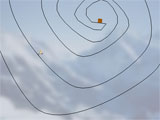
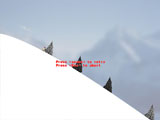
(Ski Stunt Extreme Game Screenshots)
Game Download
Download Ski Stunt Extreme here (6.13 MB). It’s just a ZIP file, for now, so run bin/SkiStunt.exe after you extract the game. If you haven’t played the original game and need the key, use:
User: freekey
Key: 5D5B-9D2A-50CA-ED67-FDEE-7827-B7F9-690F
The Future of Ski Stunt
I think there’s a lot more to be done with Ski Stunt Simulator modification. With some cleverness one could even set up longer levels that play more like a platformer than a ski simulator. There are a lot of other fun concepts that could be tried, too: a half-pipe, huge vertical drops, tunnels that snake around, etc.
Every now and then I get the itch to do more with Ski Stunt. Please leave your feedback in the comments–if there’s enough demand I could try my hand at another round of levels. It’s a lot of fun to make levels for one of the great physics games.
In our Ski Stunt Simulator interview Michiel mentions he’s considering releasing the game’s source. I really hope he does. A game like this is ripe for a community that could take things to a bold new era of physics-y goodness. And I do loves me the physics-y goodness.
Related Posts:
- Classic Physics Game: Stair Dismount
- Pogoriffic Pogo Ponies: Pogo Sticker
- Block-Stacking Fun: Solid Balance
- The Prequel to Hobo Dismount: Truck Dismount
- Insane Stunt Car Antics: Trackmania Nations



 (Rate this game! 85 votes, average: 3.59 out of 5)
(Rate this game! 85 votes, average: 3.59 out of 5)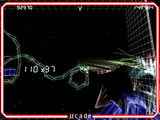
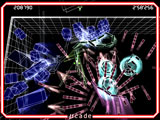
 My name is Matthew Wegner, and this site is dedicated to physics games.
My name is Matthew Wegner, and this site is dedicated to physics games.